基于WebQuest教学模式的《商务英语报刊阅读》教学设计
- 格式:doc
- 大小:33.50 KB
- 文档页数:4
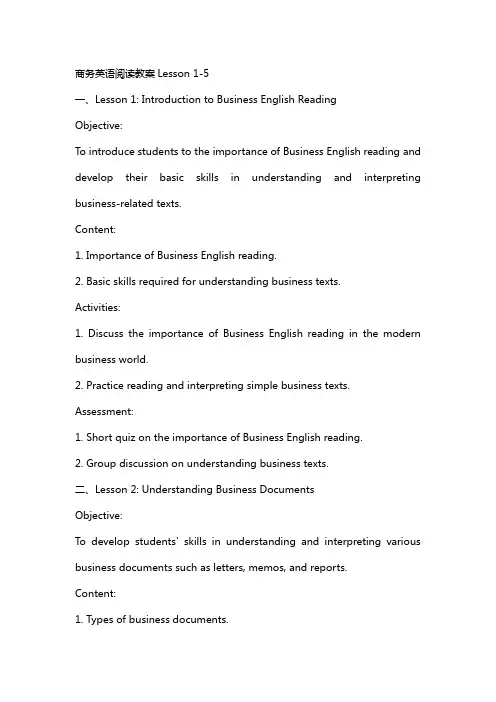
商务英语阅读教案Lesson 1-5一、Lesson 1: Introduction to Business English ReadingObjective:To introduce students to the importance of Business English reading and develop their basic skills in understanding and interpreting business-related texts.Content:1. Importance of Business English reading.2. Basic skills required for understanding business texts.Activities:1. Discuss the importance of Business English reading in the modern business world.2. Practice reading and interpreting simple business texts. Assessment:1. Short quiz on the importance of Business English reading.2. Group discussion on understanding business texts.二、Lesson 2: Understanding Business DocumentsObjective:To develop students' skills in understanding and interpreting various business documents such as letters, memos, and reports.Content:1. Types of business documents.2. Skills required for understanding business documents.Activities:1. Analyze and discuss different types of business documents.2. Practice reading and interpreting sample business documents. Assessment:1. Group activity to identify and classify different types of business documents.2. Individual assignment to read and summarize a business document.三、Lesson 3: Reading Business NewsObjective:To develop students' skills in reading and understanding business news articles, reports, and editorials.Content:1. Types of business news.2. Skills required for reading business news.Activities:1. Discuss different types of business news and their importance.2. Practice reading and interpreting sample business news articles. Assessment:1. Group discussion on understanding business news articles.2. Individual quiz on identifying and analyzing business news sources.四、Lesson 4: Understanding Financial StatementsObjective:To develop students' skills in reading and interpreting financial statements such as balance sheets, ine statements, and cash flow statements.Content:1. Types of financial statements.2. Skills required for understanding financial statements.Activities:1. Analyze and discuss different types of financial statements.2. Practice reading and interpreting sample financial statements. Assessment:1. Group activity to analyze and interpret a sample financial statement.2. Individual assignment to read and summarize a financial statement.五、Lesson 5: Reading Business Reports and ProposalsObjective:To develop students' skills in reading and understanding business reports and proposals.Content:1. Types of business reports and proposals.2. Skills required for reading business reports and proposals. Activities:1. Discuss different types of business reports and proposals.2. Practice reading and interpreting sample business reports and proposals.Assessment:1. Group activity to identify and classify different types of business reports and proposals.2. Individual assignment to read and summarize a business report or proposal.六、Lesson 6: Understanding Business CorrespondenceObjective:To develop students' skills in reading and understanding business letters, es, and memos.Content:1. Types of business correspondence.2. Skills required for understanding business correspondence. Activities:1. Discuss different types of business correspondence and their purposes.2. Practice reading and interpreting sample business letters, es, and memos.Assessment:1. Group activity to analyze and respond to a business correspondence scenario.2. Individual assignment to read, analyze, and draft a business letter or e.七、Lesson 7: Analyzing Business Case StudiesObjective:To develop students' skills in reading and analyzing business case studies to understand real-world business situations and solutions. Content:1. Types of business case studies.2. Skills required for analyzing business case studies.Activities:1. Discuss different types of business case studies and their significance.2. Practice reading and analyzing sample business case studies. Assessment:1. Group activity to analyze and discuss a business case study.2. Individual assignment to read, analyze, and present findings from a business case study.八、Lesson 8: Reading Business Contracts and Agreements Objective:To develop students' skills in reading and interpreting business contracts and agreements.Content:1. Types of business contracts and agreements.2. Skills required for reading business contracts and agreements.Activities:1. Analyze and discuss different types of business contracts and agreements.2. Practice reading and interpreting sample business contracts and agreements.Assessment:1. Group activity to analyze and interpret a sample business contract or agreement.2. Individual assignment to read, understand, and summarize a business contract or agreement.九、Lesson 9: Enhancing Reading Comprehension Strategies Objective:To enhance students' reading prehension strategies for better understanding of plex business texts.Content:1. Different reading prehension strategies.2. Applying these strategies to business texts.Activities:1. Discuss and learn different reading prehension strategies.2. Practice applying these strategies to sample business texts. Assessment:1. Group activity to demonstrate reading prehension strategies.2. Individual quiz on applying reading prehension strategies to a business text.十、Lesson 10: Evaluating and Critiquing Business TextsObjective:To develop students' skills in evaluating and critiquing business texts for their accuracy, effectiveness, and relevance.Content:1. Criteria for evaluating business texts.2. Skills required for critiquing business texts.Activities:1. Discuss the criteria for evaluating business texts.2. Practice critiquing sample business texts.Assessment:1. Group activity to evaluate and critique a business text.2. Individual assignment to read, evaluate, and write a critique of a business text.重点和难点解析一、Lesson 1 中的重点环节是理解商务英语阅读的重要性以及培养理解商务文本的基本技能。
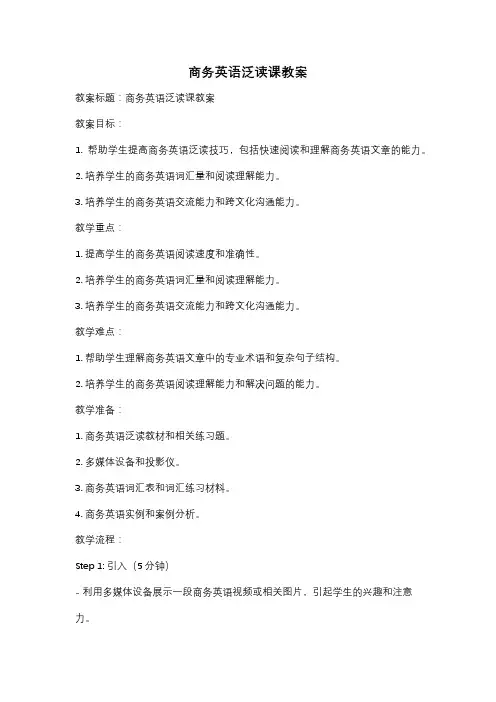
商务英语泛读课教案教案标题:商务英语泛读课教案教案目标:1. 帮助学生提高商务英语泛读技巧,包括快速阅读和理解商务英语文章的能力。
2. 培养学生的商务英语词汇量和阅读理解能力。
3. 培养学生的商务英语交流能力和跨文化沟通能力。
教学重点:1. 提高学生的商务英语阅读速度和准确性。
2. 培养学生的商务英语词汇量和阅读理解能力。
3. 培养学生的商务英语交流能力和跨文化沟通能力。
教学难点:1. 帮助学生理解商务英语文章中的专业术语和复杂句子结构。
2. 培养学生的商务英语阅读理解能力和解决问题的能力。
教学准备:1. 商务英语泛读教材和相关练习题。
2. 多媒体设备和投影仪。
3. 商务英语词汇表和词汇练习材料。
4. 商务英语实例和案例分析。
教学流程:Step 1: 引入(5分钟)- 利用多媒体设备展示一段商务英语视频或相关图片,引起学生的兴趣和注意力。
- 提问学生对商务英语泛读的了解和期望。
Step 2: 预习词汇(10分钟)- 教师介绍本课将涉及的商务英语词汇,并提供相关的词汇表和练习材料。
- 学生进行个人或小组预习,尝试理解和记忆这些词汇。
Step 3: 泛读文章(20分钟)- 教师分发商务英语泛读文章,并解释文章的背景和主题。
- 学生快速阅读文章,了解大意和主要内容。
- 学生讨论和分享对文章的理解和观点。
Step 4: 细读和理解(20分钟)- 教师引导学生细读文章,理解文章中的关键信息和细节。
- 学生进行个人或小组讨论,回答与文章相关的问题。
- 教师解答学生的问题,并提供额外的解释和例子。
Step 5: 商务英语实例和案例分析(15分钟)- 教师提供商务英语实例和案例分析,帮助学生将所学知识应用到实际情境中。
- 学生进行个人或小组讨论,分析和解决实例和案例中的问题。
- 教师引导学生总结和分享他们的分析和解决方法。
Step 6: 总结和评价(10分钟)- 教师总结本节课的重点和难点,并强调学生在泛读商务英语文章方面的进步。
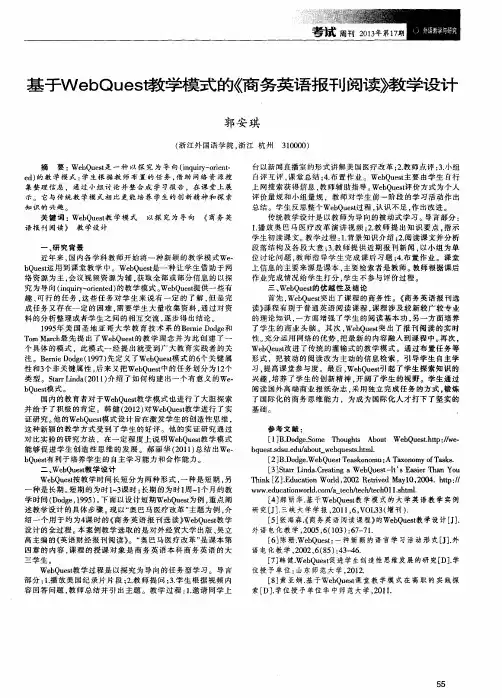
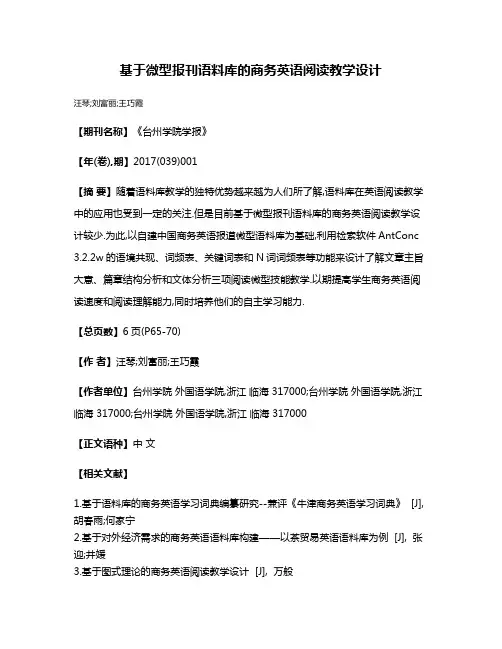
基于微型报刊语料库的商务英语阅读教学设计
汪琴;刘富丽;王巧霞
【期刊名称】《台州学院学报》
【年(卷),期】2017(039)001
【摘要】随着语料库教学的独特优势越来越为人们所了解,语料库在英语阅读教学中的应用也受到一定的关注.但是目前基于微型报刊语料库的商务英语阅读教学设计较少.为此,以自建中国商务英语报道微型语料库为基础,利用检索软件AntConc 3.2.2w的语境共现、词频表、关键词表和N词词频表等功能来设计了解文章主旨大意、篇章结构分析和文体分析三项阅读微型技能教学.以期提高学生商务英语阅读速度和阅读理解能力,同时培养他们的自主学习能力.
【总页数】6页(P65-70)
【作者】汪琴;刘富丽;王巧霞
【作者单位】台州学院外国语学院,浙江临海 317000;台州学院外国语学院,浙江临海 317000;台州学院外国语学院,浙江临海 317000
【正文语种】中文
【相关文献】
1.基于语料库的商务英语学习词典编纂研究--兼评《牛津商务英语学习词典》 [J], 胡春雨;何家宁
2.基于对外经济需求的商务英语语料库构建——以茶贸易英语语料库为例 [J], 张迎;井媛
3.基于图式理论的商务英语阅读教学设计 [J], 万般
4.基于多模态商务英语口语语料库的商务英语听说教学改革 [J], 李慧
5.基于培养英语核心素养的高中报刊阅读教学设计研究 [J], 徐菲
因版权原因,仅展示原文概要,查看原文内容请购买。
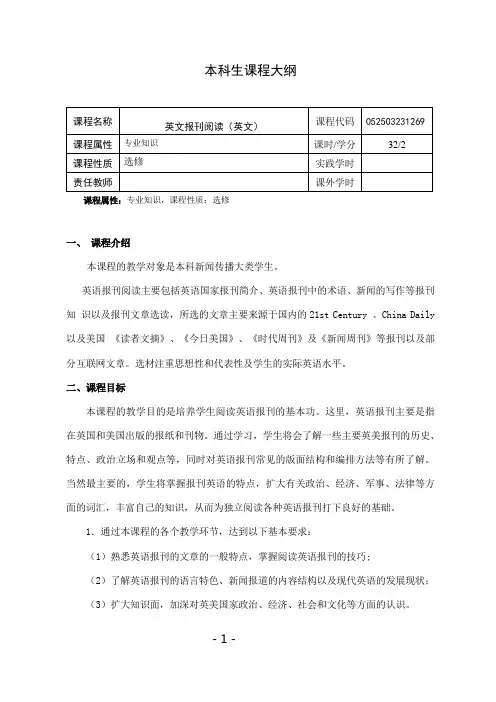
本科生课程大纲课程属性:专业知识,课程性质:选修一、课程介绍本课程的教学对象是本科新闻传播大类学生。
英语报刊阅读主要包括英语国家报刊简介、英语报刊中的术语、新闻的写作等报刊知识以及报刊文章选读,所选的文章主要来源于国内的21st Century 、China Daily 以及美国《读者文摘》、《今日美国》、《时代周刊》及《新闻周刊》等报刊以及部分互联网文章。
选材注重思想性和代表性及学生的实际英语水平。
二、课程目标本课程的教学目的是培养学生阅读英语报刊的基本功。
这里,英语报刊主要是指在英国和美国出版的报纸和刊物。
通过学习,学生将会了解一些主要英美报刊的历史、特点、政治立场和观点等,同时对英语报刊常见的版面结构和编排方法等有所了解。
当然最主要的,学生将掌握报刊英语的特点,扩大有关政治、经济、军事、法律等方面的词汇,丰富自己的知识,从而为独立阅读各种英语报刊打下良好的基础。
1.通过本课程的各个教学环节,达到以下基本要求:(1)熟悉英语报刊的文章的一般特点,掌握阅读英语报刊的技巧;(2)了解英语报刊的语言特色、新闻报道的内容结构以及现代英语的发展现状;(3)扩大知识面,加深对英美国家政治、经济、社会和文化等方面的认识。
- 1 -2.通过本课程的学习,应具备以下能力:(1)能够阅读选材广泛且具有一定的难度,如英美主要报刊、杂志中的时事评论、社论、政论、专题报道等方面的文章;(2)能够提高思想表达能力;(3)能够通过英美报刊文章的选读学习鲜活的英语,了解世界,获取必要的信息,并快速提高英语水平。
四、教学进度- 2 -五、参考教材与主要参考书1、选用教材:无,选用最新英美报刊文章作为教学素材2、主要参考书:●An ocean of English reading materials on the internet.●郝建军,刘殿刚.英语报刊阅读教程..武汉 : 武汉大学出版社, 2017.●文旭编著.英语报刊阅读教程. 北京 : 中国人民大学出版社, 2015.●Bill Kovach,Tom Rosenstiel, The Elements of Journalism, (Revised and Updated)( 3rdEdition): What Newspeople Should Know and the Public Should Expect. CA:Three Rivers Press.2014.- 3 -Bill Kovach,Tom Rosenstiel. Blur: How to Know What's True in the Age of Information Overload, New York: Bloomsbury.2010六、成绩评定(一)考核方式A:A.闭卷考试 B.开卷考试 C.论文 D.考查 E.其他(二)成绩综合评分体系:附:作业和平时表现评分标准1)作业的评分标准2)课堂讨论及平时表现评分标准- 4 -七、学术诚信学习成果不能造假,如考试作弊、盗取他人学习成果、一份报告用于不同的课程等,均属造假行为。
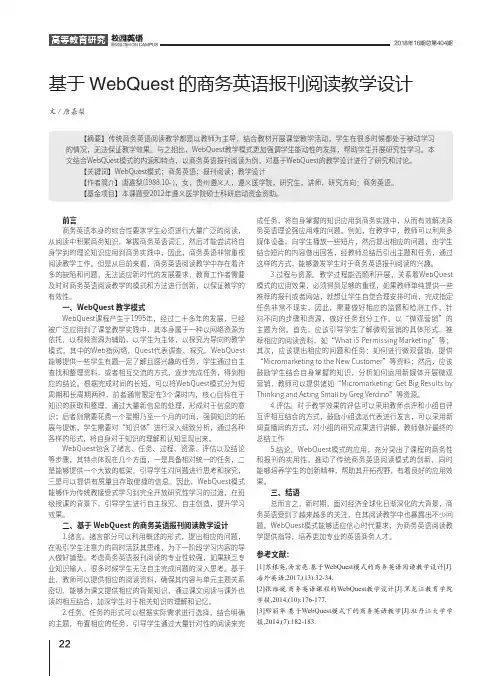
222018年16期总第404期高等教育研究ENGLISH ON CAMPUS基于WebQuest 的商务英语报刊阅读教学设计文/唐嘉梨【摘要】传统商务英语阅读教学都是以教师为主导,结合教材开展课堂教学活动,学生在很多时候都处于被动学习的情况,无法保证教学效果。
与之相比,WebQuest教学模式更加强调学生能动性的发挥,帮助学生开展研究性学习。
本文结合WebQuest模式的内涵和特点,以商务英语报刊阅读为例,对基于WebQuest的教学设计进行了研究和讨论。
【关键词】WebQuest模式;商务英语;报刊阅读;教学设计【作者简介】唐嘉梨(1988.10- ),女,贵州遵义人,遵义医学院,研究生,讲师,研究方向:商务英语。
【基金项目】本课题受2012年遵义医学院硕士科研启动资金资助。
前言商务英语本身的综合性要求学生必须进行大量广泛的阅读,从阅读中积累商务知识,掌握商务英语词汇,然后才能尝试将自身学到的理论知识应用到商务实践中,因此,商务英语非常重视阅读教学工作。
但是从目前来看,商务英语阅读教学中存在着许多的缺陷和问题,无法适应新时代的发展要求,教育工作者需要及时对商务英语阅读教学的模式和方法进行创新,以保证教学的有效性。
一、WebQuest 教学模式WebQuest课程产生于1995年,经过二十多年的发展,已经被广泛应用到了课堂教学实践中,其本身属于一种以网络资源为依托,以视频资源为辅助,以学生为主体,以探究为导向的教学模式,其中的Web指网络,Quest代表调查、探究。
WebQuest 能够提供一些学生有题一定了解且感兴趣的任务,学生通过自主查找和整理资料,或者相互交流的方式,逐步完成任务,得到相应的结论。
根据完成时间的长短,可以将WebQuest模式分为短周期和长周期两种,前者通常限定在3个课时内,核心目标在于知识的获取和整理,通过大量新信息的处理,形成对于信息的意识;后者则需要花费一个星期乃至一个月的时间,强调知识的拓展与提炼,学生需要对“知识体”进行深入细致分析,通过各种各样的形式,将自身对于知识的理解和认知呈现出来。
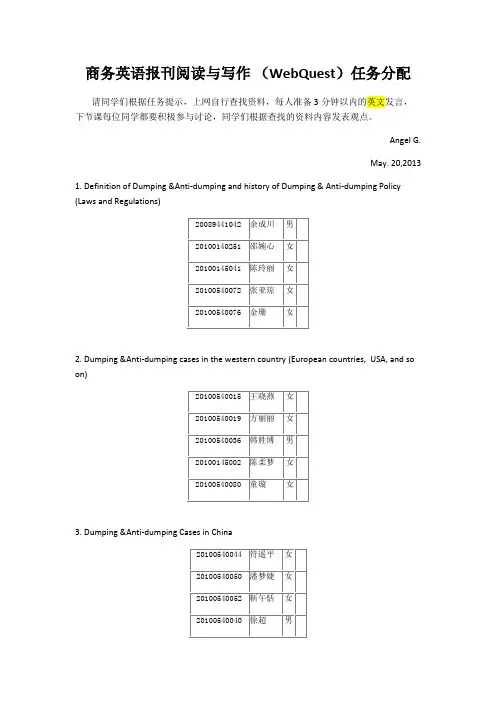
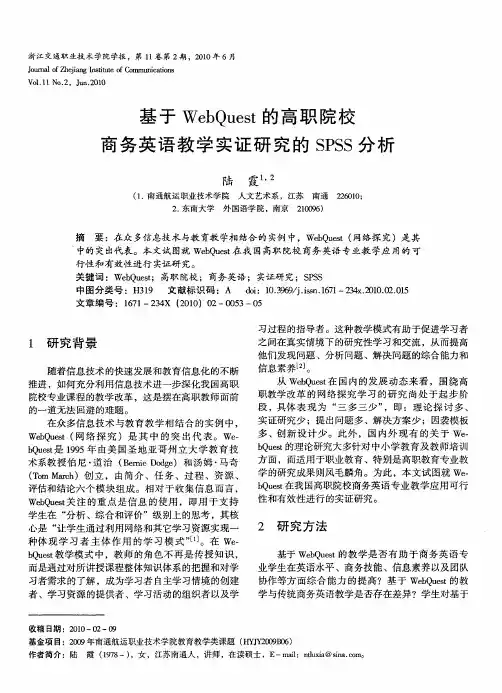

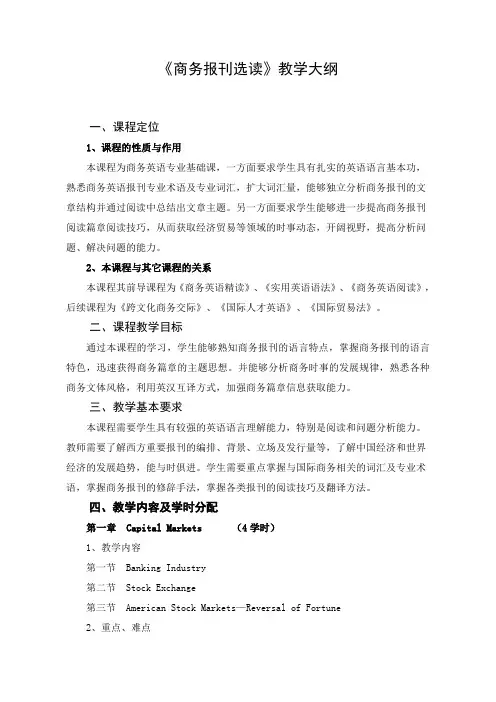
《商务报刊选读》教学大纲一、课程定位1、课程的性质与作用本课程为商务英语专业基础课,一方面要求学生具有扎实的英语语言基本功,熟悉商务英语报刊专业术语及专业词汇,扩大词汇量,能够独立分析商务报刊的文章结构并通过阅读中总结出文章主题。
另一方面要求学生能够进一步提高商务报刊阅读篇章阅读技巧,从而获取经济贸易等领域的时事动态,开阔视野,提高分析问题、解决问题的能力。
2、本课程与其它课程的关系本课程其前导课程为《商务英语精读》、《实用英语语法》、《商务英语阅读》,后续课程为《跨文化商务交际》、《国际人才英语》、《国际贸易法》。
二、课程教学目标通过本课程的学习,学生能够熟知商务报刊的语言特点,掌握商务报刊的语言特色,迅速获得商务篇章的主题思想。
并能够分析商务时事的发展规律,熟悉各种商务文体风格,利用英汉互译方式,加强商务篇章信息获取能力。
三、教学基本要求本课程需要学生具有较强的英语语言理解能力,特别是阅读和问题分析能力。
教师需要了解西方重要报刊的编排、背景、立场及发行量等,了解中国经济和世界经济的发展趋势,能与时俱进。
学生需要重点掌握与国际商务相关的词汇及专业术语,掌握商务报刊的修辞手法,掌握各类报刊的阅读技巧及翻译方法。
四、教学内容及学时分配第一章 Capital Markets (4学时)1、教学内容第一节 Banking Industry第二节 Stock Exchange第三节 American Stock Markets—Reversal of Fortune2、重点、难点重点:Knowing the stock system in banking难点:Understanding the global economic trend第二章 International Marketing (4 学时)1、教学内容第一节 Business Planning—Marketing Planning第二节 Supporting Of Online Campaign Launches with Online Marketing 第三节 Online-coupon Firms—Group on Anxiety2、重点、难点重点:Knowing how to do business planning难点:Understanding online business transaction in international market 第三章 Business Elite (4 学时)1、教学内容第一节 The Resurrection of Steve Jobs第二节 Ann Moore: The CEO of Time第三节 Steve Jobs and the iPad of Hope2、重点、难点重点:Knowing the business entrepreneur难点:Understanding the organizational structure in a company第四章 E-Commerce (4 学时)1、教学内容第一节 In E-Commerce,More Is More第二节 The Alibaba E-Commerce Empire第三节 Online Shopping: Selling Becomes Sociable2、重点、难点重点:Knowing how E-commerce runs in business难点:Understanding online shopping in community第五章Economic Globalization and Multinational Corporation (3学时) 1、教学内容第一节 Globalization VS Economic Sovereignty第二节 The World’s Top Choice第三节McDonald’s Eyes Growing Presence in Local Market2、重点、难点重点:Knowing the globalized economy难点:Understanding multinational corporation growing第六章Economic Regulations and Law (5 学时)1、教学内容第一节 US Sets 21stCentury Goal: Building a Better Patent第二节 Anti-Trust Law Treats“All Firms Equally over 140 Cases Handled 第三节 China E-Commerce Giant Launches Campaign of Fight Online Piracy 2、重点、难点重点:Knowing some business regulations and make some examples难点:Understanding the business law in international market第七章Human Resources Management ( 4学时)1、教学内容第一节 Capturing the State of Human Resources in an Annual Report第二节 The Tech Effect on Human Resources第三节 Risk Management and Human Resources Team up to Cut Absence Costs 2、重点、难点重点:Knowing the effect of human resources management in a company难点:Understanding the assessment of human resources management第八章Advertising and Publicity (44学时)1、教学内容第一节 Internet Advertising第二节 Beijing Tries to Push Beyond “Made in China”第三节 The Harder Hard Sell2、重点、难点重点:Knowing the ways of advertising难点:Understanding the importance of publicity in business第九章 Training (4学时)1、教学内容第一节 Training the Trainer第二节 Training Needs Assessment: A Must for Developing an Effective Training Program第三节An Innovative Method for Role-specific Quality-training Evaluation2、重点、难点重点:Knowing the process of training难点:Understanding the training evaluation of a employee五、课程考核本课程为考查课。
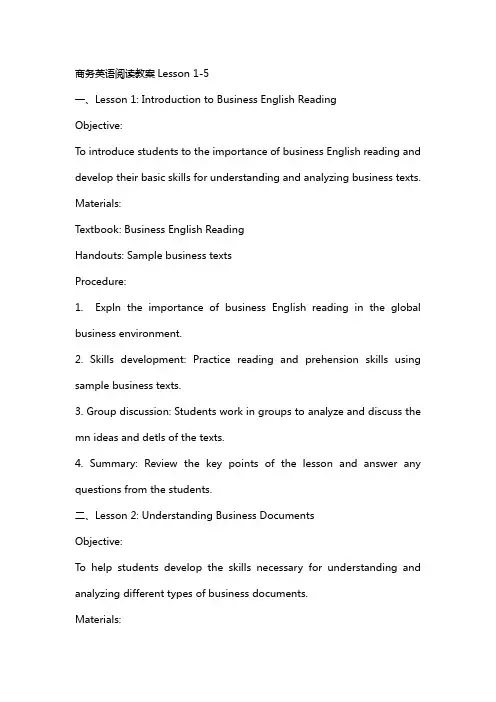
商务英语阅读教案Lesson 1-5一、Lesson 1: Introduction to Business English ReadingObjective:To introduce students to the importance of business English reading and develop their basic skills for understanding and analyzing business texts. Materials:Textbook: Business English ReadingHandouts: Sample business textsProcedure:1. Expln the importance of business English reading in the global business environment.2. Skills development: Practice reading and prehension skills using sample business texts.3. Group discussion: Students work in groups to analyze and discuss the mn ideas and detls of the texts.4. Summary: Review the key points of the lesson and answer any questions from the students.二、Lesson 2: Understanding Business DocumentsObjective:To help students develop the skills necessary for understanding and analyzing different types of business documents.Materials:Textbook: Business English ReadingHandouts: Sample business documents (e.g., memos, letters, reports) Procedure:1. Expln the purpose of business documents and their importance in business munication.2. Skills development: Practice reading and prehension skills using sample business documents.3. Group activity: Students work in groups to identify and analyze the mn ponents of the business documents.4. Summary: Review the key points of the lesson and answer any questions from the students.三、Lesson 3: Analyzing Business NewsObjective:To help students develop the skills necessary for understanding and analyzing business news articles.Materials:Textbook: Business English ReadingHandouts: Sample business news articlesProcedure:1. Expln the importance of business news in the global business environment.2. Skills development: Practice reading and prehension skills usingsample business news articles.3. Group discussion: Students work in groups to analyze and discuss the mn ideas and detls of the articles.4. Summary: Review the key points of the lesson and answer any questions from the students.四、Lesson 4: Reading Business ReportsObjective:To help students develop the skills necessary for understanding and analyzing business reports.Materials:Textbook: Business English ReadingHandouts: Sample business reportsProcedure:1. Expln the purpose of business reports and their importance in decision-making processes.2. Skills development: Practice reading and prehension skills using sample business reports.3. Group activity: Students work in groups to identify and analyze the mn sections and findings of the reports.4. Summary: Review the key points of the lesson and answer any questions from the students.五、Lesson 5: Enhancing Reading Comprehension StrategiesObjective:To help students develop effective reading prehension strategies for better understanding business texts.Materials:Textbook: Business English ReadingHandouts: Sample business texts with acpanying prehension questions Procedure:1. Discuss the importance of using prehension strategies while reading business texts.2. Skills development: Practice using various prehension strategies (e.g., predicting, skimming, scanning) while reading sample business texts.3. Group activity: Students work in groups to answer prehension questions based on the texts they have read.4. Summary: Review the key points of the lesson and answer any questions from the students.六、Lesson 6: Interpreting Business StatisticsObjective:To help students develop the skills necessary for interpreting business statistics and data presented in various formats.Materials:Textbook: Business English ReadingHandouts: Sample business texts with statistics and data tablesProcedure:1. Expln the importance of interpreting business statistics in decision-making processes.2. Skills development: Practice interpreting business statistics and data using sample texts and tables.3. Group activity: Students work in groups to analyze and interpret the statistics and data presented in the texts and tables.4. Summary: Review the key points of the lesson and answer any questions from the students.七、Lesson 7: Understanding Financial StatementsObjective:To help students develop the skills necessary for understanding and analyzing financial statements.Materials:Textbook: Business English ReadingHandouts: Sample financial statements (e.g., balance sheets, ine statements, cash flow statements)Procedure:1. Expln the purpose and importance of financial statements in business.2. Skills development: Practice understanding and analyzing financial statements using sample texts and statements.3. Group activity: Students work in groups to analyze and interpret the financial statements provided.4. Summary: Review the key points of the lesson and answer any questions from the students.八、Lesson 8: Reading Case StudiesObjective:To help students develop the skills necessary for understanding and analyzing business case studies.Materials:Textbook: Business English ReadingHandouts: Sample business case studiesProcedure:1. Expln the purpose of business case studies and their importance in learning about real-world business situations.2. Skills development: Practice reading and prehension skills using sample business case studies.3. Group discussion: Students work in groups to analyze and discuss the mn issues and solutions presented in the case studies.4. Summary: Review the key points of the lesson and answer any questions from the students.九、Lesson 9: Writing Summaries for Business TextsObjective:To help students develop the skills necessary for writing effective summaries of business texts.Materials:Textbook: Business English ReadingHandouts: Sample business texts and summary guidelines Procedure:1. Expln the importance of writing summaries for business texts and their usefulness in munication and decision-making.2. Skills development: Practice writing summaries of sample business texts using provided guidelines.3. Group activity: Students work in groups to write summaries of the texts they have read, and then exchange and discuss their summaries.4. Summary: Review the key points of the lesson, provide feedback on the students' summaries, and answer any questions from the students.十、Lesson 10: Evaluating Business Information SourcesObjective:To help students develop the skills necessary for evaluating the credibility and reliability of business information sources.Materials:Textbook: Business English ReadingHandouts: Sample business information sources (e.g., articles, websites, reports)Procedure:1. Expln the importance of evaluating business information sources and the potential risks of using unreliable information.2. Skills development: Practice evaluating the credibility and reliability of sample business information sources.3. Group activity: Students work in groups to evaluate the provided business information sources and identify their strengths and weaknesses.4. Summary: Review the key points of the lesson, discuss the students' evaluations, and answer any questions from the students.重点和难点解析一、Lesson 1: Introduction to Business English Reading补充说明:强调商务英语阅读在全球商务环境中的作用,以及如何通过练习阅读和理解商务文本来提高基本技能。
基于WebQuest教学模式的《商务英语报刊阅读》教学设计作者:郭安琪来源:《考试周刊》2013年第17期摘要: WebQuest是一种以探究为导向(inquiry-oriented)的教学模式:学生根据教师布置的任务,借助网络资源搜集整理信息,通过小组讨论并整合成学习报告,在课堂上展示。
它与传统教学模式相比更能培养学生的创新精神和探索知识的兴趣。
关键词: WebQuest教学模式以探究为导向《商务英语报刊阅读》教学设计一、研究背景近年来,国内各学科教师开始将一种新颖的教学模式WebQuest运用到课堂教学中。
WebQuest是一种让学生借助于网络资源为主,会议视频资源为辅,获取全部或部分信息的以探究为导向(inquiry-oriented)的教学模式。
WebQuest提供一些有趣、可行的任务,这些任务对学生来说有一定的了解,但是完成任务又存在一定的困难,需要学生大量收集资料,通过对资料的分析整理或者学生之间的相互交流,逐步得出结论。
1995年美国圣地亚哥大学教育技术系的Bernie Dodge和Tom March最先提出了WebQuest 的教学理念并为此创建了一个具体的模式,此模式一经提出就受到广大教育实践者的关注。
Bernie Dodge(1997)先定义了WebQuest模式的6个关键属性和3个非关键属性,后来又把WebQuest中的任务划分为12个类型。
Starr Linda(2011)介绍了如何构建出一个有意义的WebQuest模式。
国内的教育者对于WebQuest教学模式也进行了大胆探索并给予了积极的肯定。
韩健(2012)对WebQuest教学进行了实证研究。
他的WebQuest模式设计旨在激发学生的创造性思维,这种新颖的教学方式受到了学生的好评。
他的实证研究通过对比实验的研究方法,在一定程度上说明WebQuest教学模式能够促进学生创造性思维的发展。
郝丽华(2011)总结出WebQuest有利于培养学生的自主学习能力和合作能力。
《商务英语报刊选读》教学大纲1.课程的基本信息1.1.课程名称中文名称:《商务英语报刊选读》英文名称:《International Business Reading》1.2.课程代码04120731.3.学时与学分2/32 (16+16)1.4.课程性质外语必修课1.5.授课对象商务英语专业普通高职二年级学生2.课程教学目的与任务2.1.课程开设的目的商务英语报刊选读是商务英语专业学生的一门外语必修课,一方面要求学生继续打好语言基本功,熟悉报刊英语常用相关词汇和国际商务专业术语,扩大词汇量,并掌握报刊英语文章的结构与语言特点,从而提高报刊英语阅读技能和翻译技巧;另一方面要求学生进一步扩大知识面,从不同的侧面了解国际商务知识,跟踪经贸商务领域的最新动态,启迪思想,开阔视野,提高用英语分析问题、解决问题的能力。
2.2.教学目标2.2.1.理论教学目标通过本课程的教学,使学生了解世界各大主要英文通讯社及报刊,能熟知英文报刊标题的语言特色,以加强对文章内容的理解;同时要熟悉报刊英语常用相关词汇和层出不穷的与国际商务相关的专业术语,掌握报刊英语文章的结构与语言特点,以便能快速准确地获得文章的信息;此外,还要求学生学习并掌握英语新闻概要的写法。
2.2.2.能力教学目标商务英语报刊选读是一门职业技能课,因此能力教学也以技能的培养为主。
阅读理解能力:能够通过对句子结构和段落关系的分析,掌握文章大意,获取想要的信息,弄清作者的态度和意图;能够熟悉商务英语文章的各种文体风格,掌握阅读技巧,从而提高阅读理解能力和阅读速度;能够通过阅读速度的提高,获取尽量多的信息量。
英汉翻译能力:在理解文章的基础上,能够将文章大意和重要段落或句子用简单易懂的、符合汉语习惯的中文准确地表达出来。
2.2.3.思想教育目标使学生树立在当今形势下学好外语为我国社会主义现代化建设作贡献的思想,以及既能接受西方先进文化又能保持中华民族优秀传统和民族特色的精神。
商务英语阅读教学设计一、引言商务英语是指用于商务交流的英语,它包含了商务活动所需的专业词汇和表达方式。
商务英语阅读是商务英语教学的一个重要组成部分。
本文旨在设计一节商务英语阅读课的教学方案,以提高学生的商务英语阅读能力。
二、教学目标本节课的教学目标主要包括以下几个方面:1. 培养学生对商务英语阅读材料的理解能力;2. 提高学生查找商务英语文本中关键信息的能力;3. 培养学生组织和总结商务英语文本信息的能力。
三、教学内容本节课的教学内容主要包括以下几个方面:1. 商务英语阅读技巧的介绍:包括预读、快速浏览、精读等技巧;2. 商务英语阅读材料的选取:选择与商务活动相关的真实案例或文章;3. 商务英语阅读材料的分析:分析文章的结构、关键词汇和短语;4. 商务英语阅读材料的理解:引导学生理解文章的主旨和细节。
四、教学方法本节课的教学方法主要包括以下几个方面:1. 预习导入法:通过提问和讨论引导学生对商务英语阅读主题进行预习;2. 合作学习法:学生分成小组,共同解读商务英语阅读材料,互相讨论和交流;3. 情景模拟法:通过模拟商务交流场景,加深学生对商务英语阅读的理解;4. 任务驱动法:通过指定具体任务,激发学生的学习兴趣和主动性。
五、教学过程本节课的教学过程分为以下几个步骤:1. 引入:通过提问和讨论,导入商务英语阅读的主题;2. 预习导入:通过观看商务英语阅读相关视频或图片,激发学生对商务英语阅读的兴趣;3. 商务英语阅读材料解读:教师以合作学习的方式,引导学生共同解读商务英语阅读材料;4. 情景模拟:教师通过情景模拟的方式,让学生将商务英语阅读材料中的内容应用到实际场景中;5. 练习与巩固:教师设计相关练习题目,巩固学生对商务英语阅读的掌握程度;6. 总结与反思:教师引导学生总结本节课的学习成果,并进行反思。
六、教学评估本节课的教学评估主要通过以下几个方面进行:1. 学生参与度评估:观察学生在课堂上的参与状况,包括提问、回答问题和与其他学生的交流情况等;2. 学习成果评估:通过课堂练习和作业的完成情况,评估学生对商务英语阅读的掌握程度;3. 学生反馈评估:通过学生的反馈问卷或口头反馈,收集学生对本节课教学效果的评价和建议。
WebQuest教学模式在高职英语教学中的设计与应用基金项目:江西省教育科学“十三五”规划课题“基于建构主义的WebQuest教学模式在大学英语分级教学的实证研究”(编号:16YB113),主持人:曾秋霞;江西中医药大学校级教改课题“混合学习理念下微课与WebQuest相结合的教学模式在大学英语教学中的研究与实践”(编号:2016jzyb-6),主持人:曾秋霞。
早在1995年,B?Dodge和T?March便提出了WebQuest教学模式。
WebQuest作为一种全新的教学模式,相较于传统的课堂授课式教学模式,它充分借用网络资源来进行探究式学习活动的教学模式,由此给传统教学模式带来了极大的挑战。
具体来说,作为一种自觉性学习模式,WebQuest 是一种旨在利用网络在线资源和其他信息共享途径彼此互通、作用体现学习者主体效应的二语习得理念。
在该新式教学理念的的指导和引领下,课堂授课的设计与实验要首先给学生规划出一个指定的学习任务,或是一个特定的情景构思,与此同时,教师指引学生在相关互联网资源的利用和帮助下,通过对在线信息的筛查获取和分析综合,自由自主地想出、制订出颇具个性且又切实有效的实施方案或解决途径,从而帮助学生提高、培养自身高层次的思维修养和逻辑推理能力[1]。
一、WebQuest教学模式的构成及理论基础一个完整的WebQuest教学模式须由前言、任务、过程、资源、评估以及结论六个模块构成。
六个模块功能各不相同,但又环环相扣。
“前言”是指对课文主题以及学习者在开展活动时必须理解的背景知识作一个介绍,相当于教师上课前的“导入”部分。
“任务”是对主题的进一步具体化,明确提出学生在整个教学活动中需要完成的最终目标,往往以书面报告、情景剧表演、口头报告等形式呈现出来。
“过程”模块则是指为了完成任务,学生所必须经历的每个阶段与步骤,换言之,“过程”相当于是为了帮助学生完成任务,老师搭建的一个“脚手架”,组织引导学生按“脚手架”的步骤展开活动。
英语报刊阅读教学设计教案I. 教学目标1. 了解英语报刊阅读的重要性和意义。
2. 学习有效的英语报刊阅读策略和技巧。
3. 培养学生对英语报刊的兴趣和阅读能力。
II. 教学内容1. 理解英语报刊的种类和特点。
2. 学习如何选择适合自己的英语报刊。
3. 学习如何阅读英语报刊并获取准确信息。
4. 学习如何分析和评论英语报刊文章。
III. 教学过程1. 导入(5分钟)- 通过展示英语报刊的封面和标题引起学生的兴趣。
- 引导学生讨论他们平时读英语报刊的经验和困难。
- 提出本节课的学习目标和重要性。
2. 理解英语报刊(10分钟)- 结合图片和简短的介绍,让学生了解英语报刊的种类和特点。
- 引导学生讨论他们最常读的英语报刊和喜欢的栏目。
3. 如何选择英语报刊(15分钟)- 分组让学生分享他们最喜欢的英语报刊和选择标准。
- 引导学生讨论选择英语报刊的因素,例如兴趣、难度和内容。
- 教师给出一些建议和指导,如查看报刊的样版、目录和摘要。
4. 阅读技巧与策略(20分钟)- 分组让学生分享英语报刊阅读中遇到的挑战和困难。
- 教师介绍一些常用的阅读技巧和策略,如预读、扫读和精读。
- 向学生示范如何使用这些技巧,并进行实际练习。
5. 获取准确信息(15分钟)- 教师提供一篇适合学生水平的英语报刊文章。
- 引导学生使用所学的阅读技巧,抓取关键信息,提取文章主旨。
- 学生小组合作,交流和分享各自的阅读结果。
6. 分析和评论(20分钟)- 学生选择一篇感兴趣的英语报刊文章进行分析和评论。
- 引导学生思考文章的观点、论证和可信度。
- 学生小组合作,展示和讨论各自的分析和评论结果。
7. 总结与反思(5分钟)- 教师引导学生总结本节课的主要内容和收获。
- 学生表达个人的反思和感想。
- 教师给予学生积极的评价和鼓励。
IV. 教学资源1. 英语报刊的样本、封面和摘要。
2. 适合学生水平的英语报刊文章。
3. 小组合作和展示的活动指引。
Vol.18No.17引言泛读(Extensive Reading,ER)是自19世纪以来一直提倡的阅读教学法,将其添加至英语专业教学计划可保证学习者有大量真实的目标语输入,从而帮助其扩大词汇量,提高语言能力,激发阅读动机(Nakanishi&Ueda2011;Shin2003;Horst 2005;Hitosugi&Day2004)。
然而,泛读课程长期以来主要采用以教师为中心的传统教学模式,教学资源单一,多为基于教材的阅读文本,未能给学生提供真实、丰富的阅读材料;教学组织形式为以教师为中心的集体教学形式,亦未能充分调动学生在阅读文本过程中的积极性和主动性。
随着计算机技术的迅速发展,外语教师尝试将互联网及在线资源融入语言阅读课堂教学。
大量真实的网络资源可为学生提供一个真实的语言学习环境。
学生通过广泛阅读理解文本信息,选择和综合信息来处理资源信息,构建意义,更易激发阅读积极性(Alvermann,Gillis&Phelps2012)。
WebQuest由美国圣地亚哥州立大学教育技术学教授道奇(Dodge)和马奇(March)于1995年首次研发,旨在将万维网网络资源有效整合到教学中,使教师能够使用网络资源进行教学。
WebQuest 是一种“探究式”学习活动,引导学生通过利用互联网上的信息来解决问题或完成任务(Dodge 1995)。
国内外众多学者对其进行了广泛的应用与研究,认为WebQuest能够帮助学习者培养合作学习、高阶思维、语言及阅读理解能力(Godwin-Jones 2004;Al-Shamisi2016),是一种有效的语言学习活动。
基于WebQuest探究性、合作性和结构性的特点,可以考虑将其应用于英语泛读,给学习者提供激励性的阅读任务和真实的阅读材料。
学习者可依据各自的阅读任务,在课堂上通过阅读、理解、分析和综合这些预先选定的网络资源协同解决问题。
一、研究现状(一)WebQuest在外语/二语教学中的应用近年来,大量研究证实了将WebQuest应用于EFL/L2课堂的可行性和优越性。
基于WebQuest教学模式的《商务英语报刊阅读》教学设计摘要: webquest是一种以探究为导向(inquiry-oriented)的教学模式:学生根据教师布置的任务,借助网络资源搜集整理信息,通过小组讨论并整合成学习报告,在课堂上展示。
它与传统教学模式相比更能培养学生的创新精神和探索知识的兴趣。
关键词: webquest教学模式以探究为导向《商务英语报刊阅读》教学设计
一、研究背景
近年来,国内各学科教师开始将一种新颖的教学模式webquest 运用到课堂教学中。
webquest是一种让学生借助于网络资源为主,会议视频资源为辅,获取全部或部分信息的以探究为导向
(inquiry-oriented)的教学模式。
webquest提供一些有趣、可行的任务,这些任务对学生来说有一定的了解,但是完成任务又存在一定的困难,需要学生大量收集资料,通过对资料的分析整理或者学生之间的相互交流,逐步得出结论。
1995年美国圣地亚哥大学教育技术系的bernie dodge和tom march最先提出了webquest的教学理念并为此创建了一个具体的模式,此模式一经提出就受到广大教育实践者的关注。
bernie dodge (1997)先定义了webquest模式的6个关键属性和3个非关键属性,后来又把webquest中的任务划分为12个类型。
starr linda (2011)介绍了如何构建出一个有意义的webquest模式。
国内的教育者对于webquest教学模式也进行了大胆探索并给予了积极的肯定。
韩健(2012)对webquest教学进行了实证研究。
他的webquest模式设计旨在激发学生的创造性思维,这种新颖的教学方式受到了学生的好评。
他的实证研究通过对比实验的研究方法,在一定程度上说明webquest教学模式能够促进学生创造性思维的发展。
郝丽华(2011)总结出webquest有利于培养学生的自主学习能力和合作能力。
二、webquest教学设计
webquest按教学时间长短分为两种形式,一种是短期,另一种是长期。
短期的为时1~3课时;长期的为时1周~1个月的教学时间(dodge,1995)。
下面以设计短期webquest为例,重点阐述教学设计的具体步骤。
现以“奥巴马医疗改革”主题为例,介绍一个用于约为4课时的《商务英语报刊选读》webquest教学设计的全过程。
本案例教学选取的是对外经贸大学出版、吴立高主编的《英语财经报刊阅读》。
“奥巴马医疗改革”是课本第四章的内容,课程的授课对象是商务英语本科商务英语的大三学生。
webquest教学过程是以探究为导向的任务型学习。
导言部分:1.播放美国纪录片片段;2.教师提问;3.学生根据视频内容回答问题,教师总结并引出主题。
教学过程:1.邀请同学上台以新闻直播室的形式讲解美国医疗改革;2.教师点评;3.小组自评互评,课堂总结;4.布置作业。
webquest主要由学生自行上网搜索获得信息,
教师辅助指导。
webquest评价方式为个人评价量规和小组量规,教师对学生前一阶段的学习活动作出总结。
学生反思整个webquest
过程,认识不足,作出改进。
传统教学设计是以教师为导向的被动式学习。
导言部分:1.播放奥巴马医疗改革演讲视频;2.教师提出知识要点,指示学生初读课文。
教学过程:1.背景知识介绍;2.阅读课文并分析段落结构及各段大意;3.教师提供近期报刊新闻,以小组为单位讨论问题,教师指导学生完成课后习题;4.布置作业。
课堂上信息的主要来源是课本,主要检索者是教师。
教师根据课后作业完成情况给学生打分,学生不参与评价过程。
三、webquest的优越性及结论
首先,webquest突出了课程的商务性。
《商务英语报刊选读》课程有别于普通英语阅读课程,课程涉及较新较广较专业的理论知识,一方面增强了学生的阅读基本功,另一方面培养了学生的商业头脑。
其次,webquest突出了报刊阅读的实时性。
充分运用网络的优势,把最新的内容融入到课程中。
再次,webqeust改进了传统的灌输式的教学模式。
通过布置任务等形式,把被动的阅读改为主动的信息检索,引导学生自主学习,提高课堂参与度。
最后,webquest 引起了学生探索知识的兴趣,培养了学生的创新精神,开阔了学生的视野。
学生通过阅读国外高端商业报纸杂志,采用独立完成任务的方式,锻炼了国际化的商务思维能力,为成为国际化人才打下了
坚实的基础。
参考文献:
[1]b.dodge.some thoughts about webquest.http:
///about_webquests.html.
[2]b.dodge.webquest teaskonomu:a taxonomy of tasks.
[3]starr linda.creating a webquest-it’s easier than you think[z].education world,2002 retrived may10,2004. http:///a_tech/tech/tech011.shtml.
[4]郝丽华.基于webquest教学模式的大学英语教学实例研究[j].三峡大学学报,2011,6,vol33(增刊).
[5]张海森.《商务英语阅读课程》的webquest教学设计[j].外语电化教学,2005,6(103):67-71.
[6]陈珊.webquest:一种新颖的语言学习活动形式[j].外语电化教学,2002,6(85):43-46.
[7]韩健.webquest促进学生创造性思维发展的研究[d].学位授予单位:山东师范大学,2012.
[8]黄亚娴.基于webquest课堂教学模式在高职的实践探索[d].学位授予单位华中师范大学,2011.。